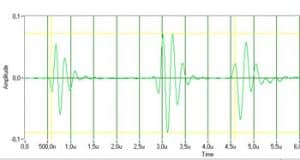Wall Thickness
Ultrasonic probes are ideal to measure wall thickness. The speed of sound of the wall material is known, so all you need to determine the wall thickness is the travel time of an ultrasound wave through the wall. As this measurement typically is done with one ultrasounic probe, the round trip is measured. A big advantages of this method is that the object only has to be accessible only from one side.
Most of the ultrasonic measuring devices on the market are quite simple. They just show the the result on a little display. The underlaying raw data you would see on an oscilloscope is thrown away. However, this raw data contains information that is indespesible for a reliable, high-resolution thickness measurement.
While in many cases those simple systems do quite a good job, more challenging measurements may cause problems. Wall thickness measurement for plastic fuel tanks is such an example. The wall of a coex fuel tank consist of a multilayer structure. Without showing the raw signal you are not sure whether you measure the total thickness or only a part of the multilayer structure.
Note: Automated detection algorithms for the correct measurement typically are custom-developed and highly adapted to a specific set of requirements. They are not part of a standard system, available upon request and in most cases require some NRE fee.

